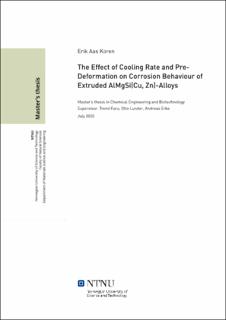| dc.contributor.advisor | Furu, Trond | |
| dc.contributor.advisor | Lunder, Otto | |
| dc.contributor.advisor | Erbe, Andreas | |
| dc.contributor.author | Koren, Erik Aas | |
| dc.date.accessioned | 2021-09-28T18:10:52Z | |
| dc.date.available | 2021-09-28T18:10:52Z | |
| dc.date.issued | 2020 | |
| dc.identifier | no.ntnu:inspera:59532294:20867944 | |
| dc.identifier.uri | https://hdl.handle.net/11250/2785285 | |
| dc.description.abstract | Aluminiumslegeringer i 6xxx-serien med høyt styrke-til-vekt-forhold kan, på grunn av vektreduksjon, bidra til å redusere utslipp av drivhusgasser i transportindustrien. Resirkulering av disse legeringene kan ytterligere bidra til å redusere klimagassutslipp, da resirkulering bare krever 5% av energibehovet nødvendig for å produsere primæraluminium. Sporelementer kan akkumulere under resirkulering, og påvirke mekaniske egenskaper og korrosjonsbestandighet til sluttproduktet. Kobber har en positiv effekt på hardhet, men reduserer bestandigheten mot intergranulær korrosjon ettersom legeringselementer segregeres til korngrenser og danner en mikrogalvanisk kobling mellom korngrensen og presipitatfrisone. Passende termomekaniskprosessering er viktig for å produsere produkter med ønsket styrke og korrosjonsbestandighet.
Fire varianter av forskjellig prosesseringsmetode og seks varianter med forskjellig kobber- og sinkinnhold ble studert. Prosesseringsmetoden ble variert ved å anvende enten vannavkjøling eller luftavkjøling i romtemperatur etter innherding, og om strekking før utherding ble utført eller ikke. Bestandigheten mot intergranulær korrosjon ble undersøkt ved bruk av ISO-standard 11846 Metode B, mens hardhet ble målt ved Vickers-hardhet. Mikrostruktur ble analysert ved bruk av polarisert lysmikroskopi, SEM og TEM.
Hardhet og bestandighet mot intergranulær korrosjon ble i større grad påvirket av varierende prosesseringsmetode enn variasjonene av kobber- og sinkinnhold som ble studert. Langsommere kjølehastighet fra innherding økte resistansen mot intergranulær korrosjon, mest sannsynlig på grunn av redusert mengde kobber på korngrensene, men reduserte den oppnådde hardheten. Pre-deformasjon reduserte alvorlighetsgraden av intergranulær korrosion, men introduserte mottakelighet for gropkorrosjon. Pre-deformasjon forårsakte redusert hardhet i vannavkjølt variant som kan skyldes lavere utherding respons. Økt kobberinnhold førte til en svak økning i hardhet, men økte vekttapet litt under korrosjonstest. Mengden sink påvirket hverken korrosjonsegenskaper eller hardhet. Resultatene understreker de motstridende effektene på mekaniske egenskaper og korrosjonsbestandighet ofte sett i AlMgSi-legeringer. | |
| dc.description.abstract | Aluminium alloys of the 6xxx-series, having a high strength-to-weight ratio, can contribute to reducing the emission of greenhouse gases (GHG) due to weight reduction in the transportation industry. Recycling of these components can further contribute to reducing GHG emission, as recycling only requires 5% of the energy required to produce primary aluminium. Trace elements may accumulate during recycling, and affect mechanical- and corrosion properties of the end product. Copper has a positive effect on hardness, however, it increases the susceptibility to intergranular corrosion (IGC). Copper segregates to the grain boundary and induces a microgalvanic coupling between grain boundary and the adjacent precipitate-free zone (PFZ). Appropriate thermomechanical processing is important to produce products with desirable strength and corrosion resistance.
Four variants of different processing route and six variants of different copper- and zinc-content was studied, resulting in a total of 24 different variants. The processing route was varied by applying either water-quenching or air-cooling after solution heat treatment (SHT) and whether pre-stretching was performed or not. IGC susceptibility was investigated by ISO Standard 11846 Method B, while hardness was measured by Vickers hardness. The microstructure was characterized by polarized light microscopy, SEM and TEM.
Variation in processing route had a more prominent effect on the IGC susceptibility and hardness than the variation of copper- and zinc-content studied. Slower cooling rate from SHT increased the IGC resistance, most likely due to a reduced amount of copper on grain boundaries. However, the reduced cooling rate also leads to decreased hardness. Pre-deformation reduced the severity of IGC attacks in water-quenched variants, but the corrosion mode transitioned into pitting corrosion. Hardness decreased in the water-quenched variant when pre-deformation was applied, which may be because of lower age-hardening response. Increased copper-content slightly increased the hardness and weight loss during IGC testing. The amount of zinc did not affect corrosion properties or hardness. Overall, the results highlight the contradicting effects of corrosion resistance and hardness of extruded AlMgSi-alloys. | |
| dc.language | | |
| dc.publisher | NTNU | |
| dc.title | The Effect of Cooling Rate and Pre-Deformation on Corrosion Behaviour of Extruded AlMgSi(Cu, Zn)-Alloys | |
| dc.type | Master thesis | |
